Netflix Supply Chain Management: An Analysis of Key Issues
VerifiedAdded on 2022/08/08
|6
|887
|113
Case Study
AI Summary
This case study analyzes the supply chain management of Netflix, focusing on the issues and challenges faced by the company. The report begins with an introduction to Netflix's virtual supply chain strategy, highlighting its benefits and limitations. The main issues discussed include limitations on content availability due to supplier practices, increased supplier power, and system overload due to high traffic. The discussion section draws on academic sources to explore these issues in detail, emphasizing the need for strategic partnerships with content providers, mitigating supplier power, and addressing information technology challenges. The report concludes with recommendations for resolving upstream supply risks, competition risks, and downstream distributor risks. These recommendations include establishing effective partnerships with content manufacturers, reducing supplier power, and forming collaborations to mitigate downstream risks.
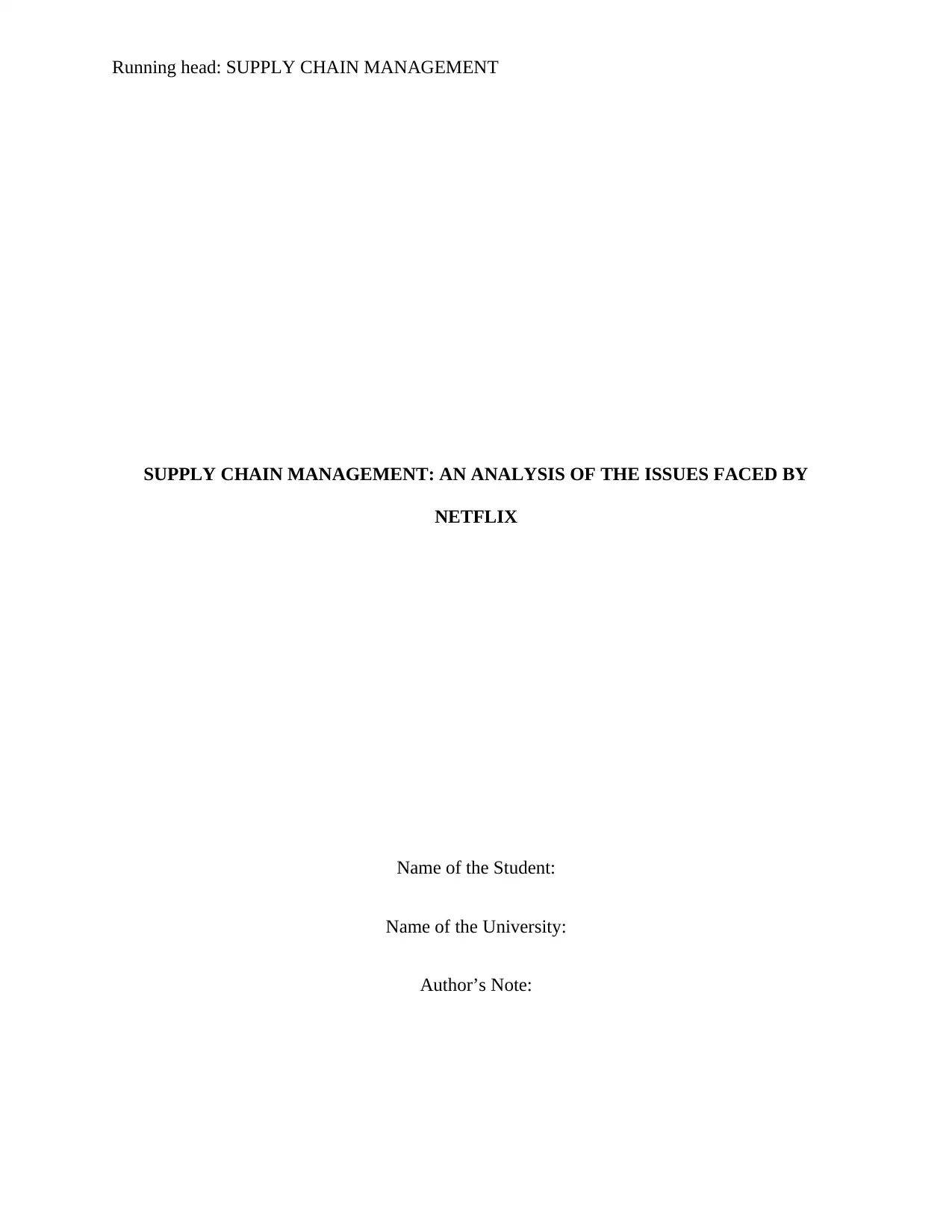
Running head: SUPPLY CHAIN MANAGEMENT
SUPPLY CHAIN MANAGEMENT: AN ANALYSIS OF THE ISSUES FACED BY
NETFLIX
Name of the Student:
Name of the University:
Author’s Note:
SUPPLY CHAIN MANAGEMENT: AN ANALYSIS OF THE ISSUES FACED BY
NETFLIX
Name of the Student:
Name of the University:
Author’s Note:
Paraphrase This Document
Need a fresh take? Get an instant paraphrase of this document with our AI Paraphraser
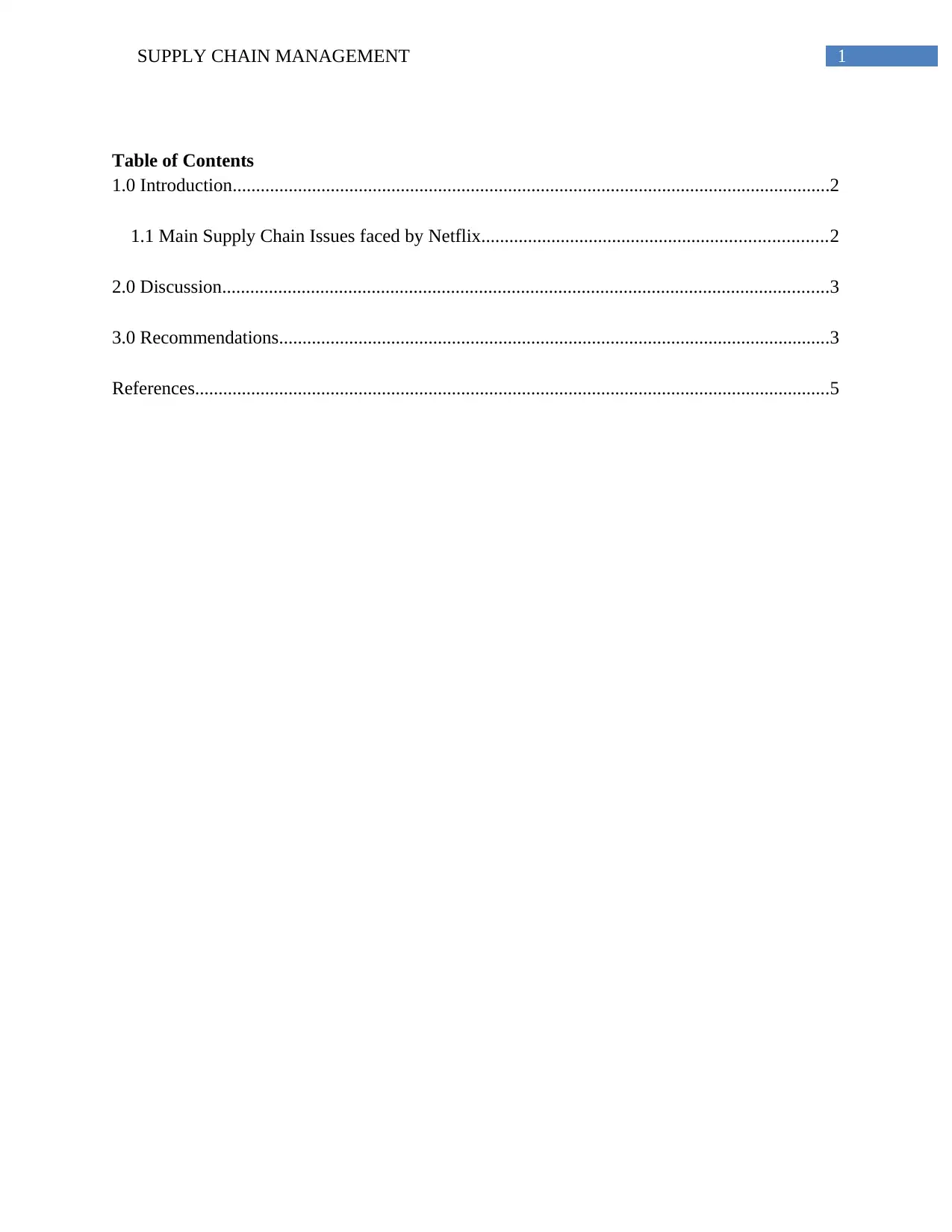
1SUPPLY CHAIN MANAGEMENT
Table of Contents
1.0 Introduction................................................................................................................................2
1.1 Main Supply Chain Issues faced by Netflix..........................................................................2
2.0 Discussion..................................................................................................................................3
3.0 Recommendations......................................................................................................................3
References........................................................................................................................................5
Table of Contents
1.0 Introduction................................................................................................................................2
1.1 Main Supply Chain Issues faced by Netflix..........................................................................2
2.0 Discussion..................................................................................................................................3
3.0 Recommendations......................................................................................................................3
References........................................................................................................................................5
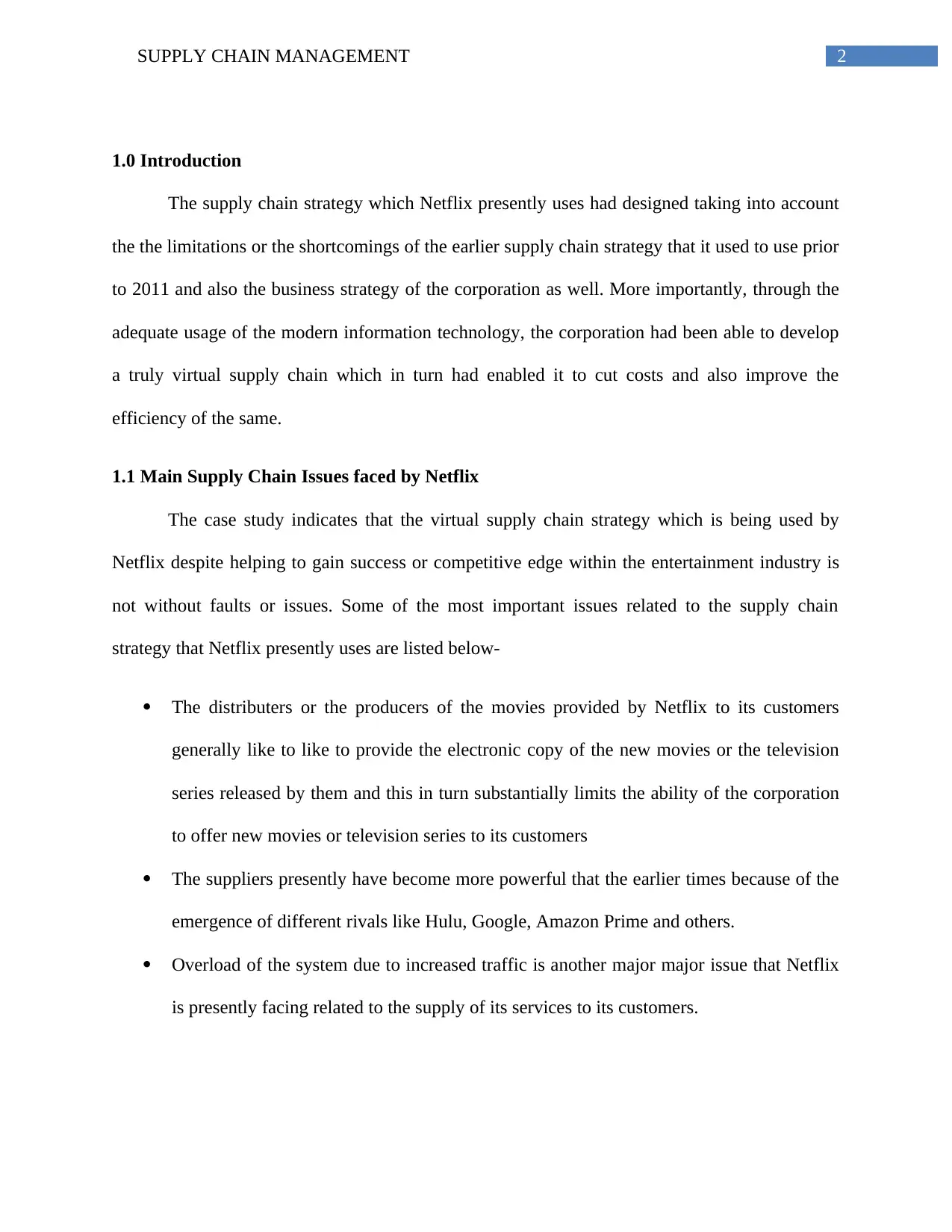
2SUPPLY CHAIN MANAGEMENT
1.0 Introduction
The supply chain strategy which Netflix presently uses had designed taking into account
the the limitations or the shortcomings of the earlier supply chain strategy that it used to use prior
to 2011 and also the business strategy of the corporation as well. More importantly, through the
adequate usage of the modern information technology, the corporation had been able to develop
a truly virtual supply chain which in turn had enabled it to cut costs and also improve the
efficiency of the same.
1.1 Main Supply Chain Issues faced by Netflix
The case study indicates that the virtual supply chain strategy which is being used by
Netflix despite helping to gain success or competitive edge within the entertainment industry is
not without faults or issues. Some of the most important issues related to the supply chain
strategy that Netflix presently uses are listed below-
The distributers or the producers of the movies provided by Netflix to its customers
generally like to like to provide the electronic copy of the new movies or the television
series released by them and this in turn substantially limits the ability of the corporation
to offer new movies or television series to its customers
The suppliers presently have become more powerful that the earlier times because of the
emergence of different rivals like Hulu, Google, Amazon Prime and others.
Overload of the system due to increased traffic is another major major issue that Netflix
is presently facing related to the supply of its services to its customers.
1.0 Introduction
The supply chain strategy which Netflix presently uses had designed taking into account
the the limitations or the shortcomings of the earlier supply chain strategy that it used to use prior
to 2011 and also the business strategy of the corporation as well. More importantly, through the
adequate usage of the modern information technology, the corporation had been able to develop
a truly virtual supply chain which in turn had enabled it to cut costs and also improve the
efficiency of the same.
1.1 Main Supply Chain Issues faced by Netflix
The case study indicates that the virtual supply chain strategy which is being used by
Netflix despite helping to gain success or competitive edge within the entertainment industry is
not without faults or issues. Some of the most important issues related to the supply chain
strategy that Netflix presently uses are listed below-
The distributers or the producers of the movies provided by Netflix to its customers
generally like to like to provide the electronic copy of the new movies or the television
series released by them and this in turn substantially limits the ability of the corporation
to offer new movies or television series to its customers
The suppliers presently have become more powerful that the earlier times because of the
emergence of different rivals like Hulu, Google, Amazon Prime and others.
Overload of the system due to increased traffic is another major major issue that Netflix
is presently facing related to the supply of its services to its customers.
⊘ This is a preview!⊘
Do you want full access?
Subscribe today to unlock all pages.

Trusted by 1+ million students worldwide
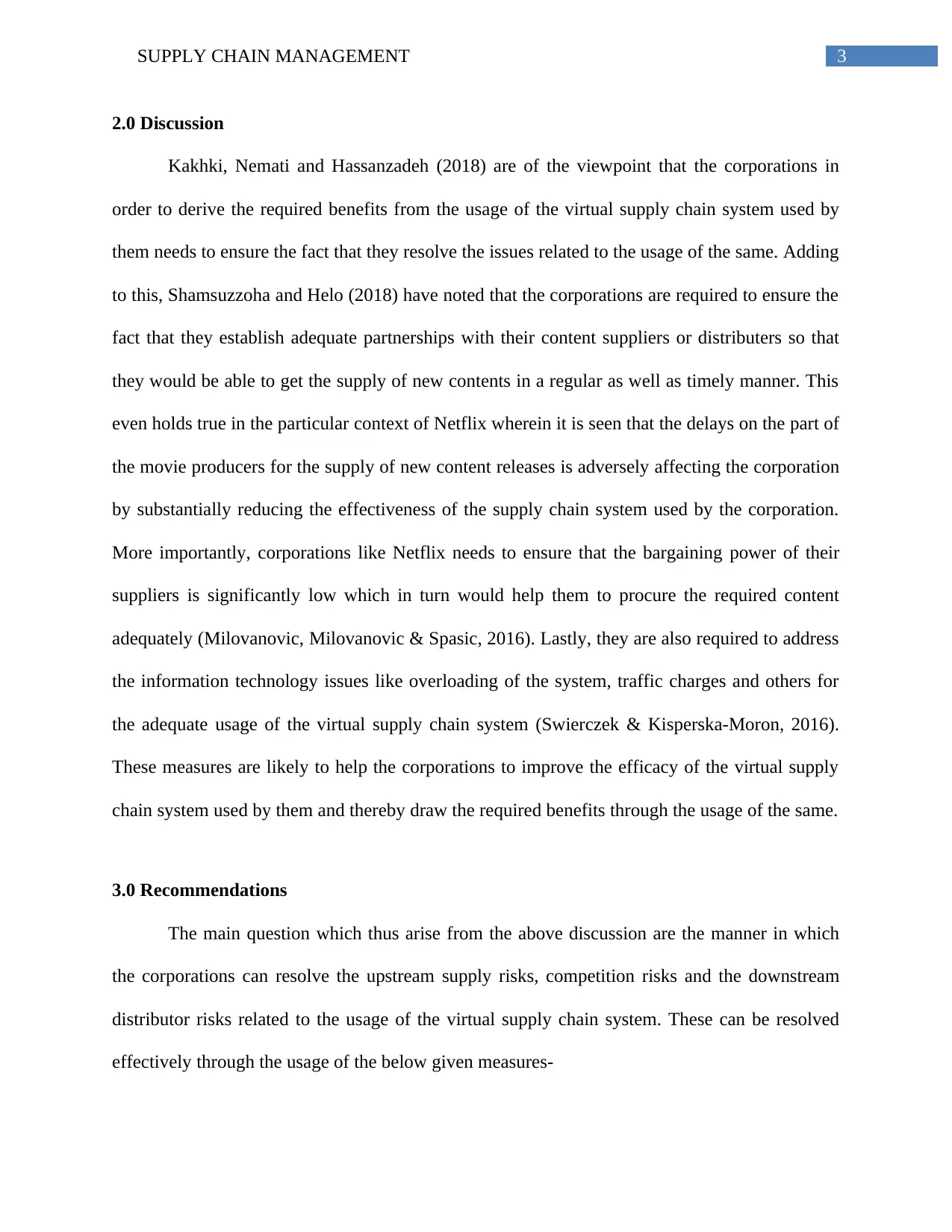
3SUPPLY CHAIN MANAGEMENT
2.0 Discussion
Kakhki, Nemati and Hassanzadeh (2018) are of the viewpoint that the corporations in
order to derive the required benefits from the usage of the virtual supply chain system used by
them needs to ensure the fact that they resolve the issues related to the usage of the same. Adding
to this, Shamsuzzoha and Helo (2018) have noted that the corporations are required to ensure the
fact that they establish adequate partnerships with their content suppliers or distributers so that
they would be able to get the supply of new contents in a regular as well as timely manner. This
even holds true in the particular context of Netflix wherein it is seen that the delays on the part of
the movie producers for the supply of new content releases is adversely affecting the corporation
by substantially reducing the effectiveness of the supply chain system used by the corporation.
More importantly, corporations like Netflix needs to ensure that the bargaining power of their
suppliers is significantly low which in turn would help them to procure the required content
adequately (Milovanovic, Milovanovic & Spasic, 2016). Lastly, they are also required to address
the information technology issues like overloading of the system, traffic charges and others for
the adequate usage of the virtual supply chain system (Swierczek & Kisperska-Moron, 2016).
These measures are likely to help the corporations to improve the efficacy of the virtual supply
chain system used by them and thereby draw the required benefits through the usage of the same.
3.0 Recommendations
The main question which thus arise from the above discussion are the manner in which
the corporations can resolve the upstream supply risks, competition risks and the downstream
distributor risks related to the usage of the virtual supply chain system. These can be resolved
effectively through the usage of the below given measures-
2.0 Discussion
Kakhki, Nemati and Hassanzadeh (2018) are of the viewpoint that the corporations in
order to derive the required benefits from the usage of the virtual supply chain system used by
them needs to ensure the fact that they resolve the issues related to the usage of the same. Adding
to this, Shamsuzzoha and Helo (2018) have noted that the corporations are required to ensure the
fact that they establish adequate partnerships with their content suppliers or distributers so that
they would be able to get the supply of new contents in a regular as well as timely manner. This
even holds true in the particular context of Netflix wherein it is seen that the delays on the part of
the movie producers for the supply of new content releases is adversely affecting the corporation
by substantially reducing the effectiveness of the supply chain system used by the corporation.
More importantly, corporations like Netflix needs to ensure that the bargaining power of their
suppliers is significantly low which in turn would help them to procure the required content
adequately (Milovanovic, Milovanovic & Spasic, 2016). Lastly, they are also required to address
the information technology issues like overloading of the system, traffic charges and others for
the adequate usage of the virtual supply chain system (Swierczek & Kisperska-Moron, 2016).
These measures are likely to help the corporations to improve the efficacy of the virtual supply
chain system used by them and thereby draw the required benefits through the usage of the same.
3.0 Recommendations
The main question which thus arise from the above discussion are the manner in which
the corporations can resolve the upstream supply risks, competition risks and the downstream
distributor risks related to the usage of the virtual supply chain system. These can be resolved
effectively through the usage of the below given measures-
Paraphrase This Document
Need a fresh take? Get an instant paraphrase of this document with our AI Paraphraser
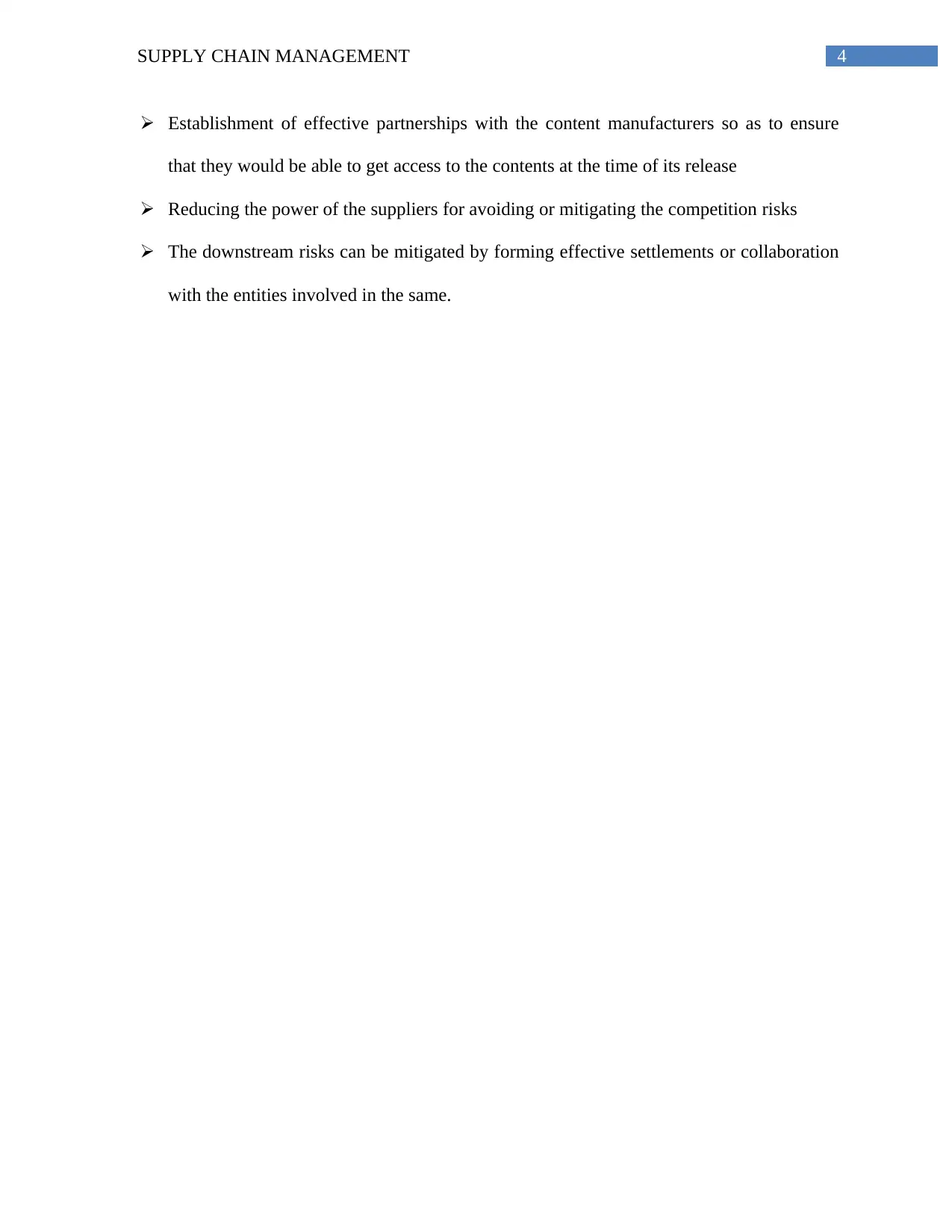
4SUPPLY CHAIN MANAGEMENT
Establishment of effective partnerships with the content manufacturers so as to ensure
that they would be able to get access to the contents at the time of its release
Reducing the power of the suppliers for avoiding or mitigating the competition risks
The downstream risks can be mitigated by forming effective settlements or collaboration
with the entities involved in the same.
Establishment of effective partnerships with the content manufacturers so as to ensure
that they would be able to get access to the contents at the time of its release
Reducing the power of the suppliers for avoiding or mitigating the competition risks
The downstream risks can be mitigated by forming effective settlements or collaboration
with the entities involved in the same.
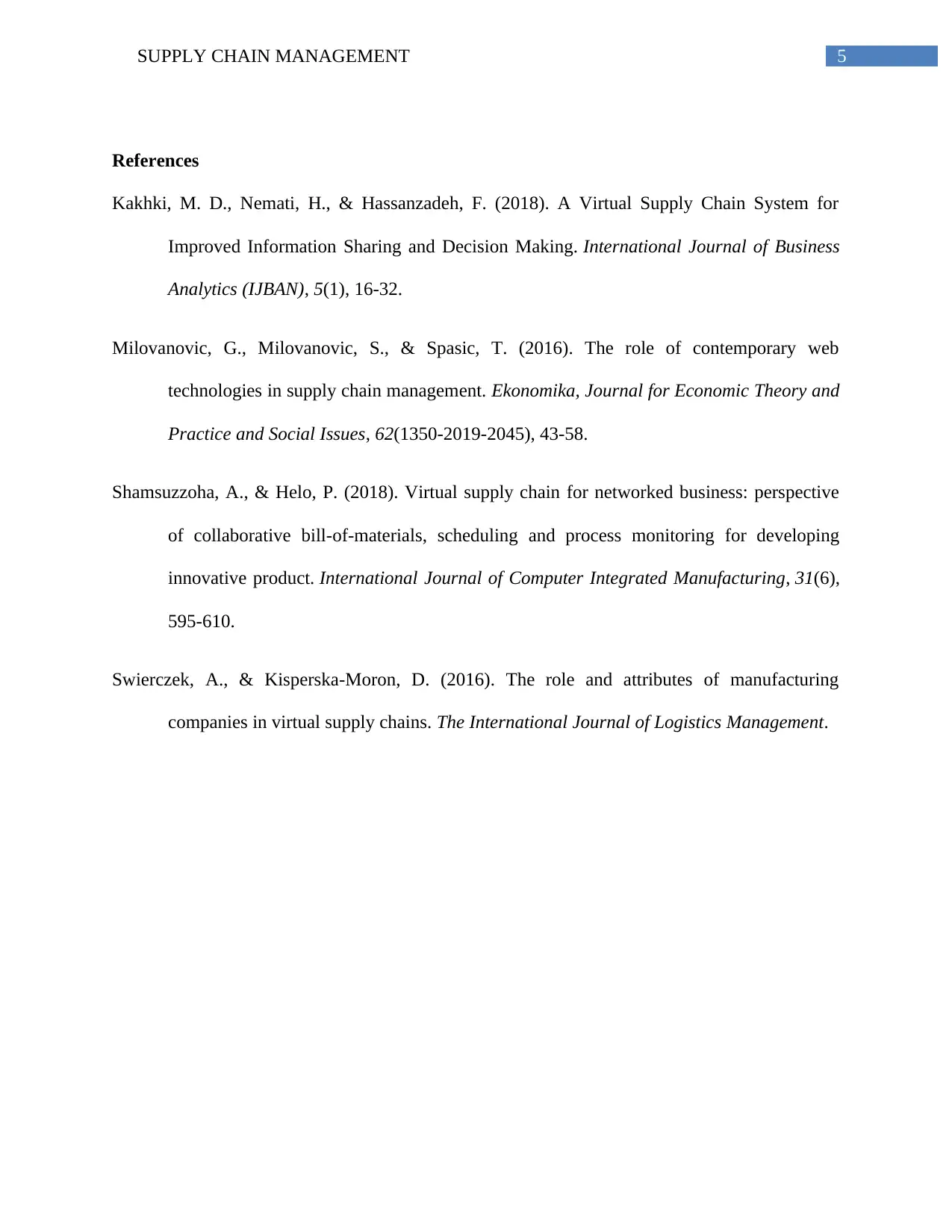
5SUPPLY CHAIN MANAGEMENT
References
Kakhki, M. D., Nemati, H., & Hassanzadeh, F. (2018). A Virtual Supply Chain System for
Improved Information Sharing and Decision Making. International Journal of Business
Analytics (IJBAN), 5(1), 16-32.
Milovanovic, G., Milovanovic, S., & Spasic, T. (2016). The role of contemporary web
technologies in supply chain management. Ekonomika, Journal for Economic Theory and
Practice and Social Issues, 62(1350-2019-2045), 43-58.
Shamsuzzoha, A., & Helo, P. (2018). Virtual supply chain for networked business: perspective
of collaborative bill-of-materials, scheduling and process monitoring for developing
innovative product. International Journal of Computer Integrated Manufacturing, 31(6),
595-610.
Swierczek, A., & Kisperska-Moron, D. (2016). The role and attributes of manufacturing
companies in virtual supply chains. The International Journal of Logistics Management.
References
Kakhki, M. D., Nemati, H., & Hassanzadeh, F. (2018). A Virtual Supply Chain System for
Improved Information Sharing and Decision Making. International Journal of Business
Analytics (IJBAN), 5(1), 16-32.
Milovanovic, G., Milovanovic, S., & Spasic, T. (2016). The role of contemporary web
technologies in supply chain management. Ekonomika, Journal for Economic Theory and
Practice and Social Issues, 62(1350-2019-2045), 43-58.
Shamsuzzoha, A., & Helo, P. (2018). Virtual supply chain for networked business: perspective
of collaborative bill-of-materials, scheduling and process monitoring for developing
innovative product. International Journal of Computer Integrated Manufacturing, 31(6),
595-610.
Swierczek, A., & Kisperska-Moron, D. (2016). The role and attributes of manufacturing
companies in virtual supply chains. The International Journal of Logistics Management.
⊘ This is a preview!⊘
Do you want full access?
Subscribe today to unlock all pages.

Trusted by 1+ million students worldwide
1 out of 6
Related Documents
Your All-in-One AI-Powered Toolkit for Academic Success.
+13062052269
info@desklib.com
Available 24*7 on WhatsApp / Email
![[object Object]](/_next/static/media/star-bottom.7253800d.svg)
Unlock your academic potential
Copyright © 2020–2025 A2Z Services. All Rights Reserved. Developed and managed by ZUCOL.





